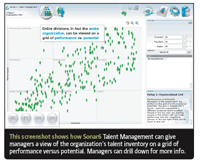As businesses compete in the emerging knowledge economy, many are focused on managing intangible assets, such as intellectual property--and that's bringing asset management into vogue.

 "Asset management" is a term guaranteed to induce a yawn. It brings to mind dull stuff about depreciation and utilization. Issues for the bean counters to worry about. As businesses compete in the emerging knowledge economy, however, many are focused on managing intangible assets, such as intellectual property--and that's bringing asset management into vogue. Still, even this new emphasis has failed to bring to innovation asset management the mindshare it deserves.
"Asset management" is a term guaranteed to induce a yawn. It brings to mind dull stuff about depreciation and utilization. Issues for the bean counters to worry about. As businesses compete in the emerging knowledge economy, however, many are focused on managing intangible assets, such as intellectual property--and that's bringing asset management into vogue. Still, even this new emphasis has failed to bring to innovation asset management the mindshare it deserves.
Why should anyone care about innovation asset management--and in any case, what exactly is it? If you buy into the notion that innovation is a core competency, you should care a great deal about innovation asset management, which means understanding, managing, monitoring, leveraging and increasing the organizational assets that support innovation efforts. Remember the four Ps of marketing: product, place, price, promotion? Well, innovation asset management has its four Ps, too: people, processes, places and patents.
These reflect many organizations' core innovation assets. The task is how to develop a management approach that improves a business' ability to use those core assets for sustained innovation.
POWER TO THE PEOPLE
People, or "talent," as people are more correctly described in innovation asset management, are key--especially those who envision and imagine new ways of doing things; generate and develop specific ideas; plan and build products; and design and market brands. That doesn't mean just the "creatives"; it also includes corporate strategists, IT developers and shop-floor manufacturers, salespeople and marketers. Plus, companies must locate the hidden subject matter experts (SMEs), opinion-formers and thought-leaders, who are often scattered in the white space of your organization chart.
The primary task of innovation asset management is to expose this talent--both to others like themselves and to the rest of the organization--and engage them in innovation efforts that matter to the business. To do this, you need human resources technology that can identify and relate these people, visualizing their social networks (as discussed in "Visualization Tools Raise Your Innovation Awareness" and capturing and codifying the kinds of knowledge they offer.
AskMe and Sonar6 are designed to help with talent management. Sonar6 offers a visual layout of your people assets (see screen, at right) that helps you to manage individual talent, develop talent pools and graph employees' respective competencies. AskMe includes a profiling engine and reputation management function to ensure SME skills are fully described and easily promoted across an organization. Don't forget you also need HR people who can understand the skills that cross-functional business objectives for innovation demand. Most surveys say companies do not have HR functions that can do this.
INNOVATION PROCESSES
Most service innovation--as opposed to product innovation--is actually delivered via process improvement. So, the organization's business processes, whether they're used to deliver a service or develop and deliver a product, are another key innovation asset. It's remarkable, but plenty of organizations still don't know their key business processes. Or, they fail to keep process maps up to date so that they reflect innovation processes that may be subject to continuous improvement.
What's more, many key innovation processes, including idea management, new product development and intellectual property management, may only be a few steps away from what the company negatively defines as unstructured and ad hoc processes. These difficult processes may be more properly understood and documented once some innovation management technology is in place.
A process repository helps companies better see what they've got. You can create a process repository using low-cost tools, such as Microsoft Office Visio, or more sophisticated products, such as Phios, which is used as the repository for the MIT Process Handbook, or Synthis, which lets you not only create and store process maps but also surround these maps with relevant content such as process documentation, best practice guides, metrics and benchmarking data. Phios has just implemented a Web-based Wiki version of its software for collaborative process mapping and maintenance. Synthis offers a compliance module for ensuring that your processes adhere to oversight or efficiency controls important to the Sarbanes-Oxley Act, ISO 9000 or Lean Six Sigma.
CREATING A PLACE FOR INNOVATION
Where does innovation happen in your organization? While people and processes reflect fluid innovation assets, places are more static. The management challenge here should be less daunting. Nevertheless, developing places for innovation and locating and booking facilities to leverage assets are still critical management tasks.
Innovation places include in-house or external incubators where "skunk work" projects may be temporarily housed to keep them away from distractions and possibly even the distrust of the rest of the organization. These places may include carefully designed creative spaces where brainstorming meetings can be convened for idea generation and development. They include showpiece facilities where innovations can be demonstrated in practice, such as at the "model office" built by Prudential UK.
Innovation asset management for places requires a form of facilities management focused on promoting the innovation-stimulation characteristics of these incubators or creative, showpiece spaces. Technology support must go beyond Microsoft Outlook in making it easy to locate and book resources, monitor utilization and assess creative output. Knowing who is using them for what presents a useful perspective on the kinds of innovation activities going on in the organization and a way of understanding whether investment in these innovation facilities is achieving some level of payback.
THE FOURTH P: PATENTS
A primary focus of intellectual property (IP) management is managing the patent portfolio, including applications, licensing and tracking of patent citations, a topic discussed in the first part of this series. Citations are a key measure of a patent's "success" in the market. A patent owned or licensed could be a key innovation asset; it must be leveraged internally and protected externally to gain optimum value from intellectual capital.
Xensis can manage patent definition and documentation as well as the application process, including tasks and correspondence and the tracking of application costs and licensing revenue. For IP management and other legal matters, Patrix Patricia (also available in an ASP version) provides sophisticated workflow capabilities. PatentCafe's ICO Suite specializes in patent analytics, which focus on better understanding of the value derived from your patent portfolio. Products from The Metrics Group also address patent analytics.
Arguably, innovation management technology itself--that is, your investment in idea management, product development and brand and IP management--is all part of your asset portfolio. Are these technologies being used fully? Analytics about technology utilization are helpful in making sure that users haven't turned products into shelfware.
WHO MANAGES INNOVATION ASSETS?
The four Ps give us the basic scope of innovation asset management. How can you ensure that your organization is actually managing assets effectively? As discussed in "Unite the Process of Innovation", one of the key organizational problems blocking effective management is that innovation is not a department or business unit activity, but one that crosses functions and involves a number of different business processes, each with its own set of stakeholders. The people, process, place and patent innovation assets could fall within the domain control of at least four different business units: HR, IT, facilities management and legal.
That's why it makes sense to put someone in the role of innovation asset manager and give that person the responsibility for maintaining oversight from a horizontal innovation perspective, rather than a vertical functional view. Otherwise, the innovation dimension gets lost in the shuffle. The tasks in this role must be more practical--but also less narrow--than what some organizations have put together for "chief innovation officers" or "idea czars."
One of the first tasks that such a manager would need to undertake, for example, is an innovation asset audit to discover what exists, where assets are and who or what department owns them. Taking advantage of work done by Goran Ekvall, a number of consulting companies already specialize in this kind of audit. Remember that you want more than a checklist. The audit should present a perspective on your organization's cultural innovation "climate." With help from Web-based tools such as Montage2 and Creax, you can develop a creativity "radar map" and determine the relevance of assets in each of the four P categories in some detail.
With the results, the audit will enable innovation asset gap analysis and risk assessment. You'll see which assets are missing, which are over- or underutilized and where the imbalances represent risks to corporate strategy. Keep in mind, of course, that an innovation audit is not just about identifying what's missing. It's also about highlighting what's not missing--then giving employees a positive, proactive and practical understanding of how best to use innovation assets. The audit will help diverse managers look cross-functionally and see how best to develop assets to further the entire organization's goals.
After the audit, plans can be put in place to fill gaps and reduce risks through process improvement, directed hiring strategies and installing new technology. Tools should include asset portfolio management software provided by vendors such as ProSight to help asset managers gain a better grip on their portfolio's scope. Organizational development techniques supported by processes such as Open Space and Appreciative Inquiry can foster a positive approach and build on the audit findings to develop innovation assets and management attributes. Finally, metrics can help managers monitor and manage specific innovation assets so that activities are in line with strategic corporate objectives.
In small-to-midsize businesses, innovation asset management might only need to be an annual housekeeping operation. In a large, complex, high-tech and multinational organization, this job might become a daily, strategically important activity. In either case, innovation asset management can't fall by the wayside. Success in today's knowledge economy depends on developing, managing and leveraging fluid rather than fixed assets. You can't capture the innovation genie in a bottle, but you can learn to work with the creative magic in your organization to establish a sustained competitive advantage.
Business InnovationThis screenshot shows how Sonar6 Talent Management can give managers a view of the organization's talent inventory on a grid of performance versus potential. Managers can drill down for more info.
Stewart Mckie is an independent IT innovation consultant. Contact him through his web site.
This article, the last in a series, is just one element of a special CMP Technology multimedia package on business innovation. For links to related stories from INFORMATIONWEEK, OPTIMIZE and NETWORK COMPUTING, and additional editorial content, including podcasts and videos, go to the Business Innovation package.
About the Author(s)
You May Also Like








